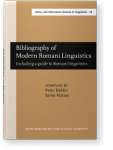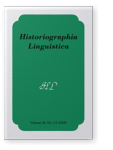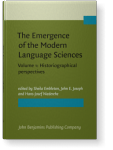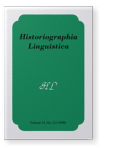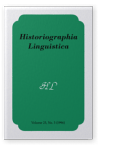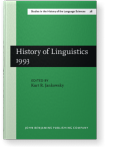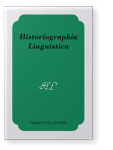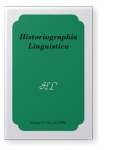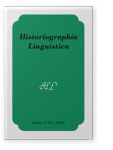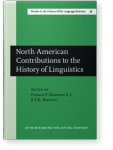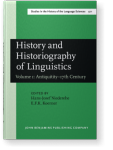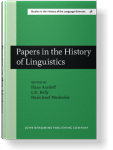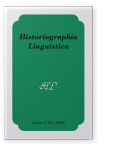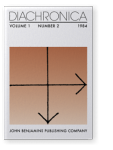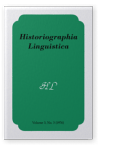Joseph L. Subbiondo
List of John Benjamins publications for which Joseph L. Subbiondo plays a role.
Book series
Title
John Wilkins and 17th-Century British Linguistics
Edited by Joseph L. Subbiondo
[Studies in the History of the Language Sciences, 67] 1992. xvi, 374 pp.
Subjects History of linguistics | Philosophy
2019 John Wilkins (1614–1672): New Essays. Edited by William Poole Historiographia Linguistica 46:1/2, pp. 191–205 | Review
2007 Competing models for a 17th century universal language: A study of the dispute between George Dalgarno and John Wilkins History of Linguistics 2005: Selected papers from the Tenth International Conference on the History of the Language Sciences (ICHOLS X), 1–5 September 2005, Urbana-Champaign, Illinois, Kibbee, Douglas A. (ed.), pp. 112–119 | Article
Many 17th-century philosophers, theologians, and educators were engaged in developing a universal language to remedy the confusion caused by the multiplicity of languages. George Dalgarno (c.1619-1687), who published Ars Signorum(The Art of Signs) in 1661, and John Wilkins (1614-1672), who… read more
2003 Lexicography and the Evolution of Consciousness: A study of Owen Barfield’s History in English Words Historiographia Linguistica 30:3, pp. 407–427 | Article
Owen Barfield (1898–1997), a cultural critic and historian, has been appreciated by literary scholars and artists including C. S. Lewis, T. S. Eliot, and W. H. Auden, but he has been relatively unnoticed by linguists despite the fact that he advanced a thoughtfully reasoned and documented theory… read more
1999 16. Linguistic Theory in Historical Perspective: A study of J.R. Firth’s The Tongues of Men The Emergence of the Modern Language Sciences: Studies on the transition from historical-comparative to structural linguistics in honour of E.F.K. Koerner, Embleton, Sheila, John E. Joseph and Hans-Josef Niederehe (eds.), pp. 237–246 | Article
1996 From pragmatics to semiotics: The influence of John Wilkins’ pulpit oratory on his philosophical language Historiographia Linguistica 23:1/2, pp. 111–122 | Article
John Wilkins’ (1614–1672) earlier work on pulpit oratory in Ecclesiastes (1646) and Gift of Prayer (1655) provide a rationale for his later work on philosophical language in his Essay towards a Real Character (1868). Clauss (1982) pointed out that one could view Wilkins’ linguistic writings as… read more
1995 Ralph Lever's Witcraft: 16th-Century Rhetoric and 17th-Century Philosophical Language History of Linguistics 1993: Papers from the Sixth International Conference on the History of the Language Sciences (ICHoLS VI), Washington DC, 9–14 August 1993, Jankowsky, Kurt R. (ed.), pp. 179–188 | Article
1992 John Wilkins' Theory of Meaning and the Development of a Semantic Model John Wilkins and 17th-Century British Linguistics, Subbiondo, Joseph L. (ed.), pp. 291–308 | Article
1992 From Babel to Eden: Comenius and the 17th-Century Philosophical Langage Movement Historiographia Linguistica 19:2/3, pp. 261–273 | Article
Starting in the 1950s, there has been renewed interest in the 17th-century English philosophical language movement and in Jan Amos Comenius (1592–1670), who visited England in 1641 and participated in that movement. In that most of the interest in Comenius has been centered on his role in the… read more
1992 John Wallis’ Grammatica Linguae Anglicanae (1653): The New Science and English Grammar Diversions of Galway: Papers on the history of linguistics from ICHoLS V, Ahlqvist, Anders (ed.), pp. 183–190 | Article
1990 Neo-aristotelian grammar in 17th-century England: Bassett Jones’ theory of rational syntax Historiographia Linguistica 17:1/2, pp. 87–98 | Article
In his Herm’œlogium; or an Essay at the Rationality of Speaking of 1659 Basset Jones intended to supplement William Lily’s (c. 1468–1522) popular 16th-century grammar, which had received the endorsement of Edward VI. Written in English and Latin, Lily’s grammar through its many editions not only… read more
1990 Leibniz and the Problem of a Universal Language. By Olga Pombo Historiographia Linguistica 17:3, pp. 406–411 | Review
1990 Neo-Aristotelian Grammar in 17th-Century England: Bassett Jones' theory of rational syntax North American Contributions to the History of Linguistics, Dinneen, S.J., Francis P. and E.F.K. Koerner † (eds.), pp. 87–98 | Article
1990 John Wilkins’ Theory of the Origin and Development of Language: Historical linguistics in 17th-century Britain History and Historiography of Linguistics: Proceedings of the Fourth International Conference on the History of the Language Sciences (ICHoLS IV), Trier, 24–28 August 1987, Niederehe, Hans-Josef and E.F.K. Koerner † (eds.), pp. 357–366 | Chapter
1987 John Wilkins' Theory of Articulatory Phonetics Papers in the History of Linguistics: Proceedings of the Third International Conference on the History of the Language Sciences (ICHoLS III), Princeton, 19–23 August 1984, Aarsleff, Hans, L.G. Kelly and Hans-Josef Niederehe (eds.), pp. 263–270 | Article
1984 Review of Bolton (1982): A Living Language: The History and Structure of English Diachronica 1:2, pp. 261–265 | Review
1981 Thomas stackhouse’s theory of linguistic rhetoric: A study of reflections on the nature and property of languages (1731) Historiographia Linguistica 8:1, pp. 47–62 | Article
Thomas Stackhouse’s (1657–1752) Reflections On the Nature and Property of Languages (1731) was directly concerned with two areas critical to an understanding of 18th century English linguistic theory: the nature and origin of language, and rhetorical grammar. Stackhouse’s method was as follows:… read more
1976 The Semantic Theory of James Harris: A Study of Hermes (1751) Historiographia Linguistica 3:3, pp. 275–291 | Article
Although the semantic theory proposed by Harris in Hermes (1751) was not well received in 18th-century England and has been generally neglected by scholars ever since, it is certainly deserving of our attention because it is a perceptive analysis of the logico-semantic structure of language. In… read more
